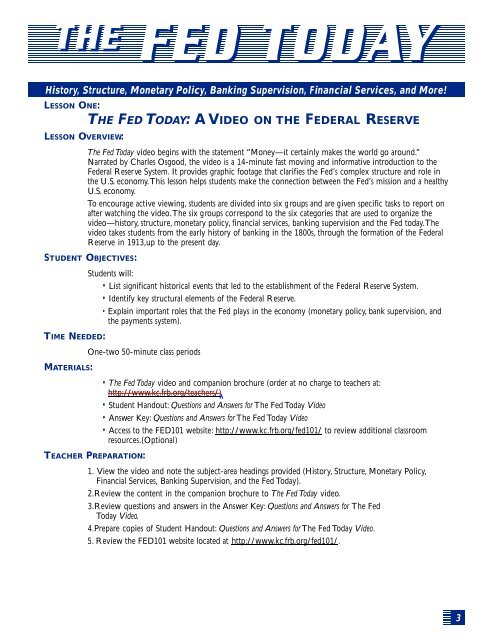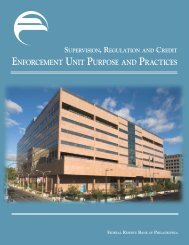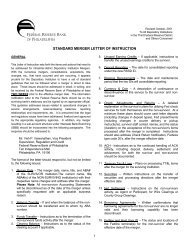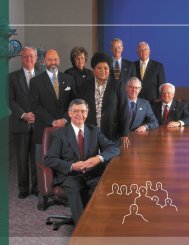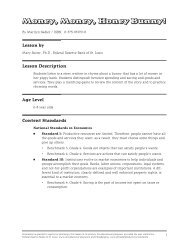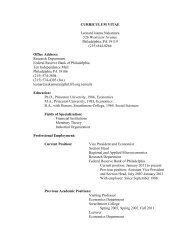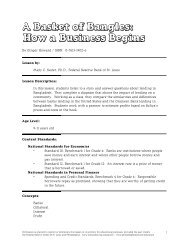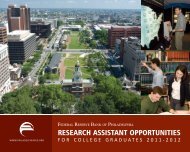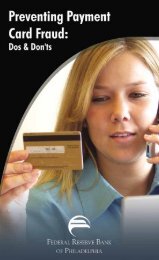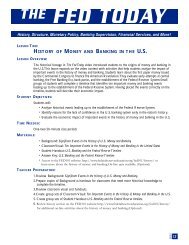The Fed Today: Lesson One - Federal Reserve Bank of Philadelphia
The Fed Today: Lesson One - Federal Reserve Bank of Philadelphia
The Fed Today: Lesson One - Federal Reserve Bank of Philadelphia
Create successful ePaper yourself
Turn your PDF publications into a flip-book with our unique Google optimized e-Paper software.
T H E F E D T O DAY<br />
H i s t o ry, Stru c t u re, Monetary Policy, <strong>Bank</strong>ing Supervision, Financial Services, and More !<br />
LESSON ONE:<br />
LESSON OVERVIEW:<br />
THE FED TODAY: A VIDEO ON THE FEDERAL RESERVE<br />
<strong>The</strong> <strong>Fed</strong> <strong>Today</strong> video begins with the statement “Money—it certainly makes the world go around.”<br />
Narrated by Charles Osgood, the video is a 14-minute fast moving and informative introduction to the<br />
<strong>Fed</strong>eral <strong>Reserve</strong> System. It provides graphic footage that clarifies the <strong>Fed</strong>’s complex structure and role in<br />
the U.S. economy.This lesson helps students make the connection between the <strong>Fed</strong>’s mission and a healthy<br />
U.S. economy.<br />
To encourage active viewing, students are divided into six g roups and are given specific tasks to report on<br />
after watching the video.<strong>The</strong> six groups correspond to the six categories that are used to organize the<br />
video—history, structure, monetary policy, financial services, banking supervision and the <strong>Fed</strong> today.<strong>The</strong><br />
video takes students from the early history <strong>of</strong> banking in the 1800s, through the formation <strong>of</strong> the <strong>Fed</strong>eral<br />
<strong>Reserve</strong> in 1913,up to the present day.<br />
STUDENT OBJECTIVES:<br />
TIME NEEDED:<br />
MATERIALS:<br />
Students will:<br />
• List significant historical events that led to the establishment <strong>of</strong> the <strong>Fed</strong>eral <strong>Reserve</strong> System.<br />
• Identify key structural elements <strong>of</strong> the <strong>Fed</strong>eral <strong>Reserve</strong>.<br />
• Explain important roles that the <strong>Fed</strong> plays in the economy (monetary policy, bank supervision, and<br />
the payments system).<br />
<strong>One</strong>-two 50-minute class periods<br />
TEACHER PREPARATION:<br />
• <strong>The</strong> <strong>Fed</strong> <strong>Today</strong> video and companion brochure (order at no charge to teachers at:<br />
http://www.kc.frb.org/teachers/)<br />
• Student Handout: Questions and Answers for <strong>The</strong> <strong>Fed</strong> <strong>Today</strong> Video<br />
• Answer Key: Questions and Answers for <strong>The</strong> <strong>Fed</strong> <strong>Today</strong> Video<br />
• Access to the FED101 website: http://www.kc.frb.org/fed101/ to review additional classroom<br />
resources.(Optional)<br />
1. View the video and note the subject-area headings provided (History, Structure, Monetary Policy,<br />
Financial Services, <strong>Bank</strong>ing Supervision, and the <strong>Fed</strong> <strong>Today</strong>).<br />
2.Review the content in the companion brochure to <strong>The</strong> <strong>Fed</strong> <strong>Today</strong> video.<br />
3.Review questions and answers in the Answer Key: Questions and Answers for <strong>The</strong> <strong>Fed</strong><br />
<strong>Today</strong> Video.<br />
4.Prepare copies <strong>of</strong> Student Handout: Questions and Answers for <strong>The</strong> <strong>Fed</strong> <strong>Today</strong> Video.<br />
5. Review the FED101 website located at http://www.kc.frb.org/fed101/.<br />
3
T H E F E D T O DAY<br />
ACTIVITY:<br />
PROCEDURES:<br />
Understanding the <strong>Fed</strong>’s Role in the U.S. Economy<br />
1.Begin the lesson by showing students a one-dollar bill and ask if they know how this makes the world<br />
go around.Ask students to look at their own bills and find the words “<strong>Fed</strong>eral <strong>Reserve</strong> Note.” Find out<br />
how much the students already know about the <strong>Fed</strong>eral <strong>Reserve</strong> and its role in the U.S. economy.<br />
2.Announce that the class will be viewing a video on the <strong>Fed</strong>eral <strong>Reserve</strong> that will give them an overview<br />
<strong>of</strong> the <strong>Fed</strong> from its founding to the present day.<br />
3. Divide the class into six groups and distribute Student Handout:Questions and Answers for <strong>The</strong> <strong>Fed</strong> <strong>Today</strong><br />
Video. Give each group a topic with a title that corresponds to a category in the video: history, structure,<br />
monetary policy, financial services, banking supervision, and the <strong>Fed</strong> today. Have the groups make a name<br />
tent or small sign with their group topic.<br />
4. Explain that the task for each group, after watching the video, is to make a report that mentions at least<br />
five things group members learned about their topic (topics include history, banking supervision, etc.).<br />
Students may use the Student Handout as a starting point and add items to the list. Specify that at the<br />
end <strong>of</strong> the video, all group members will have time to prepare their class report.<strong>The</strong>y will need to share<br />
information so that they can include five items. <strong>One</strong> person in each group will be the spokesperson.<br />
5. Show <strong>The</strong> <strong>Fed</strong> <strong>Today</strong> video (14 minutes).Allow students time to prepare their reports.Work with each<br />
group to encourage every student to share his or her notes and recollections for the presentation.<br />
6.Acknowledge and summarize the reports from each <strong>of</strong> the six groups.Use the Answer Key: Question and<br />
Answers for <strong>The</strong> <strong>Fed</strong> <strong>Today</strong> Video (at the end <strong>of</strong> <strong>Lesson</strong> <strong>One</strong>) to further clarify or expand on information<br />
presented by students representing each <strong>of</strong> the six groups.<strong>The</strong>se questions can also be used as a way to<br />
evaluate the lesson, as a homework assignment, or as part <strong>of</strong> a weekly quiz.<br />
7. Teacher Summary: Explain to students that the <strong>Fed</strong>eral <strong>Reserve</strong> plays an important role in the U.S.<br />
economy.Ask for student participation to summarize the following main points:<br />
• History—During the 1800s,people routinely lost faith in the banking and financial system. Paper<br />
money could be printed by states, cities,and private businesses.<strong>The</strong> <strong>Fed</strong>eral <strong>Reserve</strong> Act was passed<br />
in 1913 to create a safer and more stable monetary and banking system.<br />
• Structure—<strong>The</strong> <strong>Fed</strong>eral <strong>Reserve</strong> is a “decentralized central bank” with both private and public<br />
elements operating independently within the government.<strong>The</strong> Board <strong>of</strong> Governors <strong>of</strong> the <strong>Fed</strong>eral<br />
<strong>Reserve</strong> is a government agency.<strong>The</strong> 12 <strong>Fed</strong>eral <strong>Reserve</strong> <strong>Bank</strong>s are not government agencies; they<br />
represent the private component <strong>of</strong> the <strong>Fed</strong>.<br />
• Monetary Policy—<strong>The</strong> primary focus <strong>of</strong> monetary policy is price stability.<strong>The</strong> body that is<br />
charged with setting monetary policy is the <strong>Fed</strong>eral Open Market Committee, which regulates the<br />
amount <strong>of</strong> money and credit in the economy.<br />
• Financial Services—<strong>The</strong> <strong>Fed</strong>eral <strong>Reserve</strong> is <strong>of</strong>ten called “the bankers’ bank”because it provides<br />
financial institutions with high quality currency and coin,processes checks and electronic payments,<br />
and encourages new payment technologies.<br />
• <strong>Bank</strong> Supervision—To enhance public confidence in banks, the <strong>Fed</strong> promotes the safety and<br />
soundness <strong>of</strong> the banking system.<strong>Bank</strong> examiners analyze financial records, risk,and compliance and<br />
can require banks to take corrective action if necessar y.<br />
• <strong>The</strong> <strong>Fed</strong> <strong>Today</strong>—As banking practices and laws have evolved, the <strong>Fed</strong> has adapted to these changes<br />
by helping to write additional banking laws and incorporate new technologies. Emerging<br />
democracies have used the <strong>Fed</strong> as a model when modifying their central banks.<br />
4
T H E F E D T O DAY<br />
EXTENDING THE LESSON:<br />
DISCUSSION POINT:<br />
Have students visit the FED101 website at: http://www.kc.frb.org/fed101/policy/ to learn more about the<br />
role <strong>of</strong> the <strong>Fed</strong> in the U.S. economy and take an on-line quiz.<br />
Myth:<br />
<strong>The</strong> <strong>Fed</strong>eral <strong>Reserve</strong> Act was passed illegally under a cloak <strong>of</strong> secrecy and was started by an elite<br />
group <strong>of</strong> private bankers.<br />
REALITY:<br />
<strong>The</strong> <strong>Fed</strong>eral <strong>Reserve</strong> System was created by the <strong>Fed</strong>eral <strong>Reserve</strong> Act and signed into law by<br />
President Woodrow Wilson on December 23, 1913.Although the Act was passed in the final<br />
days <strong>of</strong> the legislative session,it had been debated for some time in earlier versions.Because the<br />
regional <strong>Fed</strong>eral <strong>Reserve</strong> <strong>Bank</strong>s are privately owned,and most <strong>of</strong> their directors are chosen by<br />
their stockholders,it is common to hear that control <strong>of</strong> the <strong>Fed</strong> is in the hands <strong>of</strong> elite bankers.<br />
However, individuals do not own stock in <strong>Fed</strong>eral <strong>Reserve</strong> <strong>Bank</strong>s.<strong>The</strong> stock is held only by<br />
banks that are members <strong>of</strong> the system. Ownership and membership are synonymous.<br />
5
T H E F E D T O DAY<br />
Student Handout<br />
QUESTIONS AND ANSWERS FOR THE FED TODAY VIDEO<br />
HISTORY:<br />
People Lacked Confidence in Money and <strong>Bank</strong>ing during the 1800s<br />
QUESTION:<br />
Who was allowed to issue paper money during the 1800s?<br />
ANSWER:<br />
QUESTION:<br />
Why did some people lose faith in the banking system before the <strong>Fed</strong>eral <strong>Reserve</strong> System was in place?<br />
ANSWER:<br />
QUESTION:<br />
When was the <strong>Fed</strong>eral <strong>Reserve</strong> Act passed,and which U.S. President signed it into law?<br />
ANSWER:<br />
STRUCTURE:<br />
<strong>The</strong> <strong>Fed</strong>eral <strong>Reserve</strong> is a System Comprised <strong>of</strong> Regional and National Components<br />
QUESTION:<br />
Why is the <strong>Fed</strong> sometimes called a decentralized central bank that’s both public and private?<br />
ANSWER:<br />
QUESTION:<br />
What are the “checks and balances”in place when a <strong>Fed</strong> governor is appointed to the Board <strong>of</strong><br />
Governors?<br />
ANSWER:<br />
QUESTION:<br />
What are the three primary roles <strong>of</strong> the 12 <strong>Fed</strong>eral <strong>Reserve</strong> <strong>Bank</strong>s?<br />
ANSWER:<br />
6
T H E F E D T O DAY<br />
MONETARY POLICY:<br />
<strong>The</strong> <strong>Fed</strong>’s Primary Goal is Price Stability<br />
QUESTION:<br />
What is the primary focus <strong>of</strong> monetary policy?<br />
ANSWER:<br />
QUESTION:<br />
What decision does the <strong>Fed</strong>eral Open Market Committee make when it meets?<br />
ANSWER:<br />
QUESTION:<br />
According to <strong>The</strong> <strong>Fed</strong> <strong>Today</strong> video, what are the economic conditions that may lead to inflation?<br />
ANSWER:<br />
BANK SUPERVISION:<br />
<strong>The</strong> <strong>Fed</strong> Promotes a Safe and Sound <strong>Bank</strong>ing System<br />
QUESTION:<br />
Who establishes the laws that govern the supervision and regulation <strong>of</strong> banking institutions that operate in<br />
the U.S.?<br />
ANSWER:<br />
QUESTION:<br />
Why does the <strong>Fed</strong> attempt to make banks both safe and sound?<br />
ANSWER:<br />
QUESTION:<br />
What do <strong>Fed</strong>eral <strong>Reserve</strong> bank examiners analyze when they examine a bank?<br />
ANSWER:<br />
7
T H E F E D T O DAY<br />
FINANCIAL SERVICES:<br />
<strong>The</strong> <strong>Fed</strong> Helps to Maintain a Reliable Payments System<br />
QUESTION:<br />
Why is it so important that the <strong>Fed</strong> play a vital role in the U.S. payments system?<br />
ANSWER:<br />
QUESTION:<br />
Why is the <strong>Fed</strong> <strong>of</strong>ten called “the bankers’ bank?”<br />
ANSWER:<br />
QUESTION:<br />
Why is the <strong>Fed</strong> considered to be the government’s bank?<br />
ANSWER:<br />
THE FED TODAY:<br />
<strong>The</strong> <strong>Fed</strong> Adapts to a Changing Financial System<br />
QUESTION:<br />
What is the mission <strong>of</strong> the <strong>Fed</strong>eral <strong>Reserve</strong>, and what is its short name?<br />
ANSWER:<br />
QUESTION:<br />
How have <strong>Fed</strong>eral <strong>Reserve</strong> <strong>Bank</strong>s adapted to be able to process more than 20 billion checks per year?<br />
ANSWER:<br />
QUESTION:<br />
Why are other central banks from around the world interested in how the <strong>Fed</strong>eral <strong>Reserve</strong> operates?<br />
ANSWER:<br />
8
T H E F E D T O DAY<br />
Answer Key<br />
HISTORY:<br />
STRUCTURE:<br />
QUESTIONS AND ANSWERS FOR THE FED TODAY VIDEO<br />
People Lacked Confidence in Money and <strong>Bank</strong>ing during the 1800s<br />
QUESTION:<br />
Who was allowed to issue paper money during the 1800s?<br />
SUGGESTED ANSWER:<br />
Over 30,000 different notes were issued by states,banks, and private companies during much <strong>of</strong> the<br />
1800s.<br />
QUESTION:<br />
Why did some people lose faith in the banking system before the <strong>Fed</strong>eral <strong>Reserve</strong> System was in<br />
place?<br />
SUGGESTED ANSWER:<br />
Sometimes banks did not have enough money to pay depositors, and they had to temporarily close<br />
their doors or permanently go out <strong>of</strong> business.<br />
QUESTION:<br />
When was the <strong>Fed</strong>eral <strong>Reserve</strong> Act passed,and which U.S. President signed it into law?<br />
SUGGESTED ANSWER<br />
In 1913 the <strong>Fed</strong>eral <strong>Reserve</strong> Act was signed into law by President Woodrow Wilson.<br />
<strong>The</strong> <strong>Fed</strong>eral <strong>Reserve</strong> is a System Comprised <strong>of</strong> Regional and National Components<br />
QUESTION:<br />
Why is the <strong>Fed</strong> sometimes called a decentralized central bank that’s both public and private?<br />
SUGGESTED ANSWER:<br />
<strong>The</strong> <strong>Fed</strong>eral <strong>Reserve</strong> consists <strong>of</strong> two main entities—the Board <strong>of</strong> Governors and the 12 <strong>Fed</strong>eral<br />
<strong>Reserve</strong> <strong>Bank</strong>s.<strong>The</strong> Board <strong>of</strong> Governors is a public agency.<strong>The</strong> 12 <strong>Fed</strong>eral <strong>Reserve</strong> <strong>Bank</strong>s and their<br />
boards <strong>of</strong> directors represent the private component <strong>of</strong> the <strong>Fed</strong>.<br />
QUESTION:<br />
What are the “checks and balances” in place when a <strong>Fed</strong> governor is appointed to the Board <strong>of</strong><br />
Governors?<br />
SUGGESTED ANSWER:<br />
Each <strong>of</strong> the seven members <strong>of</strong> the Board <strong>of</strong> Governors is nominated by the President, but must also be<br />
confirmed by the Senate.<br />
QUESTION:<br />
What are the three primary roles <strong>of</strong> the 12 <strong>Fed</strong>eral <strong>Reserve</strong> <strong>Bank</strong>s?<br />
SUGGESTED ANSWER:<br />
<strong>The</strong> three primary roles <strong>of</strong> <strong>Fed</strong>eral <strong>Reserve</strong> <strong>Bank</strong>s are providing economic analysis, delivering financial<br />
services to banks, and supervising banks.<br />
9
T H E F E D T O DAY<br />
MONETARY POLICY:<br />
BANK SUPERVISION:<br />
<strong>The</strong> <strong>Fed</strong>’s Primary Goal is Price Stability<br />
QUESTION:<br />
What is the primary focus <strong>of</strong> monetary policy?<br />
SUGGESTED ANSWER:<br />
Price stability is the primary focus <strong>of</strong> monetary policy.<br />
QUESTION:<br />
What decision does the <strong>Fed</strong>eral Open Market Committee make when it meets?<br />
SUGGESTED ANSWER:<br />
<strong>The</strong> <strong>Fed</strong>eral Open Market Committee regulates the amount <strong>of</strong> money and credit that is available for<br />
the economy.<br />
QUESTION:<br />
According to <strong>The</strong> <strong>Fed</strong> <strong>Today</strong> video, what are the economic conditions that may lead to inflation?<br />
SUGGESTED ANSWER:<br />
Inflation may result when the supply <strong>of</strong> money grows faster than the production <strong>of</strong> goods and<br />
services.<br />
<strong>The</strong> <strong>Fed</strong> Promotes a Safe and Sound <strong>Bank</strong>ing System<br />
QUESTION:<br />
Who establishes the laws that govern the supervision and regulation <strong>of</strong> banking institutions that<br />
operate in the U.S.?<br />
SUGGESTED ANSWER:<br />
Congress establishes the laws,and the <strong>Fed</strong>eral <strong>Reserve</strong>, along with other <strong>Fed</strong>eral and state regulators,<br />
makes sure these rules are followed.<br />
QUESTION:<br />
Why does the <strong>Fed</strong> attempt to make banks both safe and sound?<br />
SUGGESTED ANSWER:<br />
Stable and healthy banks enhance public confidence in the financial system.<br />
QUESTION:<br />
What do <strong>Fed</strong>eral <strong>Reserve</strong> bank examiners analyze when they examine a bank?<br />
SUGGESTED ANSWER:<br />
<strong>Fed</strong>eral <strong>Reserve</strong> <strong>Bank</strong> examiners review financial records,look for potential risks in bank investments,<br />
and ensure that banks follow applicable banking regulations.<br />
10
T H E F E D T O DAY<br />
FINANCIAL SERVICES:<br />
THE FED TODAY:<br />
<strong>The</strong> <strong>Fed</strong> Helps to Maintain a Reliable Payments System<br />
QUESTION:<br />
Why is it so important that the <strong>Fed</strong> play a vital role in the U.S. payments system?<br />
SUGGESTED ANSWER:<br />
<strong>The</strong> transfer <strong>of</strong> funds from one bank to another is a key component <strong>of</strong> keeping banks safe and reliable.<br />
QUESTION:<br />
Why is the <strong>Fed</strong> <strong>of</strong>ten called “the bankers’bank?”<br />
SUGGESTED ANSWER:<br />
Because the <strong>Fed</strong> provides banks with financial services, such as check processing, electronic payments,<br />
and new currency and coin.<br />
QUESTION:<br />
Why is the <strong>Fed</strong> considered to be the government’s bank?<br />
SUGGESTED ANSWER:<br />
<strong>The</strong> <strong>Fed</strong>eral <strong>Reserve</strong> maintains the U.S.Treasury’s account, facilitates the collection <strong>of</strong> federal taxes,<br />
and issues and redeems Treasury securities.<br />
<strong>The</strong> <strong>Fed</strong> Adapts to a Changing Financial System<br />
QUESTION:<br />
What is the mission <strong>of</strong> the <strong>Fed</strong>eral <strong>Reserve</strong>, and what is its short name?<br />
SUGGESTED ANSWER:<br />
<strong>The</strong> mission <strong>of</strong> the <strong>Fed</strong>eral <strong>Reserve</strong>, <strong>of</strong>ten referred to as the <strong>Fed</strong>, is to maintain public confidence in<br />
our nation’s monetary and banking system.<br />
QUESTION:<br />
How have <strong>Fed</strong>eral <strong>Reserve</strong> <strong>Bank</strong>s adapted to be able to process more than 20 billion checks per year?<br />
SUGGESTED ANSWER:<br />
New processing and computer technologies have enabled the <strong>Fed</strong> to adapt to a constantly changing<br />
banking industry.<br />
QUESTION:<br />
Why are other central banks from around the world interested in how the <strong>Fed</strong>eral <strong>Reserve</strong> operates?<br />
SUGGESTED ANSWER:<br />
Some emerging democracies from around the world are using the <strong>Fed</strong> as a model as they improve<br />
their own central banks.<br />
11
T H E F E D T O DAY<br />
NOTES:<br />
12


